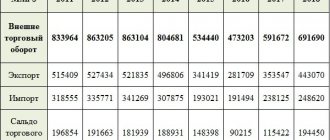12.04.2016
You may be interested in May 21, 2021
Training seminar “Documentary tools for banking support of international trade”
Export-import transactions, as a rule, involve the use of certain standard documents and forms, in particular, proforma invoice, purchase order, commercial invoice (invoice) , documentary letter of credit, bill of lading, certificate of origin of goods, act (certificate) of inspection of goods, consular invoice, packing list and insurance certificate. Merchants involved in international trade should be aware of the correct use of these documents, as well as the potential pitfalls that each of these documents contains.
What foreign exchange transactions can business entities carry out?
Foreign exchange transactions are the acquisition by a resident from a resident or non-resident, the acquisition by a non-resident from a resident, the alienation by a resident in favor of a resident or non-resident, the alienation by a non-resident in favor of a resident of foreign currency assets legally, as well as the use of foreign currency assets as a means of payment (Article 1 of the Federal Law of 10.12 .2003 No. 173-FZ “On Currency Regulation and Currency Control”).
Russian organizations may conduct foreign exchange transactions permitted by current foreign exchange legislation, including purchasing and selling foreign currency, receiving foreign currency proceeds from the sale of goods (works, services), purchasing goods (works, services) with settlements in foreign currency, provided that the supplier is a non-resident, receive loans (credits) in foreign currency.
To carry out foreign exchange transactions, organizations must fulfill a number of requirements:
- carry out transactions through bank accounts of authorized banks, or through accounts in banks located outside the Russian Federation;
- provide documents related to the currency transaction to the authorized bank;
- when making payments to non-residents, repatriate foreign currency earnings.
Types of contracts according to Incoterms 2010
In Incoterms 2010, there are four groups of contract types . This classification is based on two principles: determining the obligations of the parties in relation to the transportation of the goods supplied and increasing the scope of the seller’s obligations. The use of a particular term limits the type of vehicle or method of transportation, and may also provide for mandatory insurance of the cargo by the party/parties. In table 1 indicates which term should be used for each type of transport, what the terms of the basic conditions of supply mean.
Table 1
Classification of trade terms "Incoterms 2010"
| Name of trade terms | Kind of transport | Notes | |
| Group E. Departure | |||
| EXW | Ex-factory (...name of place) | any types of transport | Franco-enterprise... (specified place) means that the seller is considered to have fulfilled his obligations to supply the goods when he made the goods available to the buyer directly on his territory (for example, plant, factory, warehouse, etc.). The seller is not responsible for loading the goods onto the vehicle provided by the buyer, nor for paying customs duties, nor for customs clearance of the exported goods, unless specifically agreed upon. The buyer bears all risks and all costs of moving the goods from the seller’s territory to the specified destination |
| Group F. Main carriage not paid | |||
| FCA | Free carrier (...name of destination) FREE CARRIER | any types of transport | Free carrier... (specified place) means that the seller is deemed to have fulfilled his obligations to deliver the goods when he has handed over the goods, cleared for export, to the carrier nominated by the buyer at the specified place or point. The parties should most clearly define the point at the named place of delivery, since the risk passes to the buyer at this point. The seller is required to complete export formalities, if applicable. However, the seller is not required to complete customs formalities for importation, pay import duties or carry out other customs formalities for importation |
| F.A.S. | Free along the side of the vessel (...name of the port of shipment) FREE ALONGSIDE SHIP | sea and inland waterway transport | Free alongside the ship... (specified port of shipment) means that the seller is deemed to have fulfilled his obligation to deliver the goods when the goods are placed alongside the ship at the berth or in lighters at the named port of shipment. Only from this moment the buyer bears all costs and risks of loss or damage to the goods. The responsibility for ensuring customs clearance and obtaining an export license lies with the seller |
| FOB | Free on board (...name of the port of shipment) FREE ON BOARD (NAMED PORT OF SHIPMENT) | sea and inland waterway transport | Free on board... (named port of shipment) means that the seller is deemed to have fulfilled his obligation to deliver the goods when the goods have passed the ship's rail at the named port of shipment. Thus, from this moment (that is, starting from the stevedoring costs of placing the cargo in the holds of the vessel - trimming), the buyer bears all costs and the entire risk of loss or damage to the goods. Under FOB, the seller is responsible for clearing the goods for export. This basis can only be applied when transporting cargo by water transport (sea, river) |
| Group C. The main carriage is paid, that is, the seller enters into a contract of carriage and places the goods in the care of the carrier | |||
| CFR | Cost and freight (...name of destination port) COST AND FREIGHT (NAMED PORT OF DESTINATION) | sea and inland waterway transport | Cost and freight... (named port of destination) means that the seller bears the costs and freight necessary to deliver the goods to the named port of destination. In this case, the risk of loss and damage to the goods, as well as any additional costs due to events occurring after delivery of the goods on board the ship, passes from the seller to the buyer when the goods pass the ship's rail at the port of shipment. Under the CFR basis, the seller has the responsibility to clear the goods for export. |
| CIF | Cost, insurance and freight (...name of destination port) COST, INSURANCE, FREIGHT (NAMED PORT OF DESTINATION) | sea and inland waterway transport | Cost, insurance and freight... (specified port of destination) means that the seller has the same obligations as under the terms of "Cost and freight", but with the addition that he is obliged to ensure that the cargo is insured against the risks of loss and damage for the benefit of the recipient . The seller concludes an insurance contract, pays the insurance premium and sends the policy along with other documents to the recipient |
| CPT | Carriage paid to (...name of destination) CARRIAGE PAID TO (NAMED PLACE OF DESTINATION) | any types of transport | Freight paid to... (destination specified) means that the seller pays freight for transporting the goods to the specified destination. The risk of loss or damage to the goods, as well as any additional costs arising after delivery of the goods to the carrier, passes from the seller to the buyer when the goods are placed at the disposal of the first carrier. Since risk and costs pass from the seller to the buyer in two different places, it is recommended that the parties, as clearly as possible, define in the contract the place of delivery of the goods at which the risk passes to the buyer, as well as the named destination to which the seller is obliged to enter into a contract of carriage. If required, the seller must, at his own expense and risk, obtain an export license or other official authorization and complete all customs formalities necessary for the export of the goods and their transportation through any country before delivery of the goods. The seller is obliged to pay, if necessary, the costs of completing customs formalities necessary for the export of goods, as well as duties, taxes and charges paid upon export, as well as the costs of transporting them through third countries, if they are borne by the seller under the terms of the contract of carriage |
| C.I.P. | Cost and insurance paid to (...name of destination) CARRIAGE AND INSURANCE PAID TO (NAMED PLACE OF DESTINATION) | any types of transport | Cost and insurance paid to... (named destination) means that the seller hands over the goods to the carrier at the agreed place (if such a place is agreed upon by the parties). The seller is obliged to enter into a contract of carriage and bear the costs of carriage necessary to deliver the goods to the agreed destination. In addition, he enters into an insurance contract covering the risk of loss or damage to the goods during transportation. The buyer should note that under the CIP the seller is required to provide only minimum coverage insurance. If the buyer wishes to have more protection through insurance, he must agree with the seller or obtain additional insurance at his own expense. The seller's obligations under this basis include payment, if required, of the costs of completing customs formalities necessary for the export of goods, as well as duties, taxes and charges paid upon export, as well as the costs of transporting them through third countries, if they are under the terms of the contract transportation is the responsibility of the seller |
| Group D. Arrival | |||
| DAP | Delivered At Piont (…named point of destination) | any types of transport | Delivery at terminal (...name of terminal) means that the seller delivers when the goods, unloaded from the arriving means of transport, are made available to the buyer at the agreed terminal at the named port or place of destination. The seller bears all risks associated with the delivery of the goods and their unloading at the terminal at the named port or place of destination. A terminal is any place, closed or open: a pier, a warehouse, a container yard or a road, rail or air cargo terminal. This delivery condition is used from 01/01/2011 instead of DAF, DES and DDU |
| DAT | Delivered At Terminal (…named terminal of destination) | any types of transport | Delivered at destination... (name of terminal) means that the seller delivers when the goods are placed at the disposal of the buyer on an arriving means of transport ready for unloading at the agreed place of destination. The seller bears all risks associated with the delivery of the goods to the specified location. The seller has no obligation to the buyer to conclude an insurance contract. This delivery condition is used from 01/01/2011 instead of DEQ |
| DDP | Delivery Duty Paid (...name of destination) DELIVERY DUTY PAID (NAMED PLACE OF DESTINATION) | any types of transport | Delivered Duty Paid ... (named destination) means that the seller delivers when the goods are placed at the buyer's disposal, cleared of duties required for import, on the arriving means of transport, ready for unloading at the named place of destination. The seller bears all costs and risks associated with the delivery of the goods to the place of destination and is obliged to complete the customs formalities required not only for export but also for import, pay any duties levied on export and import, and complete all customs formalities |
How to account for export/import transactions in accounting and tax accounts?
As you know, the export of goods is subject to VAT at a rate of 0%, which should be reflected in the accounting of export operations of your organization. To confirm the right to apply the “zero” VAT rate, you must provide copies of the supply agreement and customs declaration to the Federal Tax Service. The period for confirmation of the 0% rate is 180 days from the date of authorized release of goods specified in the customs declaration. If the deadline has expired and the documents are not provided on time, then it is necessary to charge VAT and submit an updated VAT return for the quarter in which the shipment occurred.
Import operations involving the import of goods into the territory of the Russian Federation are recognized as subject to VAT. In this case, the tax base for VAT is determined as the sum of the customs value of goods and the customs duty payable.
VAT must be paid within the period from the moment of registration of the customs declaration and until the moment the goods are released by the customs authority.
The amount of VAT paid when importing goods into the territory of the Russian Federation after they have been accepted for accounting is accepted for deduction, but subject to the availability of primary documents and documents confirming the actual payment of VAT.
| Export | Import |
| Revenue from the sale of goods is recognized on the date of transfer of ownership from the organization to the buyer and is reflected by posting Dt 62 Kt 90.1 cost of goods sold is included in cost of sales Dt 90.2 Kt 41 customs duty is included in other expenses Dt 91.2 Kt 60 (76) | The purchase of goods is accepted for accounting at actual cost. Dt 41 Kt 60 VAT payment is reflected Dt 76 Kt 51 based on the customs declaration, VAT paid upon import is reflected Dt 19 Kt 76 settlements have been made with the supplier Dt 60 Kt 52 Exchange differences arising on the date of settlements are reflected as part of other income or expenses in correspondence with account 52 |
Contents of basic delivery conditions
When concluding a foreign trade contract, the basic terms of delivery are of particular importance, as they influence the formation of additional expenses of the organization, and, consequently, the expected financial result of the export operation. The delivery basis is special conditions that define the obligations of the parties to a foreign trade transaction to deliver goods from the point of departure to the agreed destination and establish the moment of transfer of risks of accidental loss or damage to the goods from the seller to the buyer, as well as the moment the exporter fulfills the obligations to supply the goods. Basic conditions establish the basis (basis) of the price depending on whether delivery costs are included in the price of the goods or not. Those costs for delivery of goods that are borne by the seller are included in the price of the goods.
Which documents in the 1C program reflect these operations?
| Export | 1. Document “Sales of goods” with a VAT rate of 0%, the total amount of the document must be equal to the amount of the customs declaration on line 22; 2. Based on the “Sales of goods”, a document “Customs declaration (export)” is created, which indicates the VAT transaction code, mode of transport, and accompanying document; 3. Customs duties are written off using the document “Accounting Certificate”. |
| Import | 1. Document “Receipt of goods”, in which the total amount of all documents must be equal to the amount according to the customs declaration, line 22; 2. Based on the “Receipt of Goods”, a document “Customs Declaration (Import)” is created, which reflects the amounts of customs duty, customs duty, customs VAT and customs value. Please note that the customs value may include transport costs to the border in accordance with the terms of delivery according to Incoterms 2010 If goods are imported from member states of the EAEU on the basis of the “Receipt of Goods” document, a document “Application for the Import of Goods” is created. |
Import accounting
As part of accounting, imported goods and materials are reflected at their actual cost. The procedure for its determination is prescribed in paragraph 6 of the Accounting Regulations “Accounting for Inventory and Inventory” (PBU 5/01). The same procedure is also relevant for determining the initial cost of purchased fixed assets. In accounting, actual expenses for the purchase of imported products include these expenses:
- Amounts as agreed with the counterparty.
- Payment for information and advice purchased in connection with an import transaction.
- Customs duty.
- Non-refundable taxes on product purchase.
- Remuneration to the intermediary who participated in the import transaction.
- Expenses for product delivery and insurance.
- Expenses for raising loans.
- Expenses to bring products to a state suitable for use.
- Payment for banking services.
The following entries appear in the importer’s accounting:
- DT07, 08, 10, 15, 41 KT60. Posting of imported products. The primary document is the waybill.
- DT07, 07, 10, 15, 41 KT60. Expenses for transportation, insurance of goods based on the provisions of Incoterms.
When transporting products through customs, a duty is charged. It is reflected in column 47 of the customs declaration.
Accounting entries used
When performing import operations, these entries are made:
- DT07, 8, 10, 12, 41 KT76. Accrual of customs duties.
- DT76 KT51, 52. Payment of customs duties.
- DT19 KT76. Calculation of customs VAT.
- DT76 KT51, 52. Payment of VAT at customs.
- DT68 KT19. Acceptance of VAT for deduction.
Accounting for customs duties is determined by the procedure for taxation of imported products. The above entries apply if VAT can be deducted. Imported products may be subject to excise duties. In this case, these entries are executed:
- DT7, 8, 10, 15, 41, 19 KT76. Calculation of excise tax, which is paid at customs.
- DT76 KT51, 52. Payment of excise duty at the customs border.
To reflect customs payments, it is recommended to open subaccounts to account 76:
- 1 – duty.
- 2 – fee in Russian currency.
- 3 – customs duty in foreign currency.
- 4 – payment of customs VAT.
Specific sub-accounts are opened depending on the needs of a particular company.
Let's look at all the wiring used:
- DT60 KT52. Transfer of funds to a foreign counterparty.
- DT76 KT51. Payment of customs duties.
- DT07 KT60. Receipt of foreign equipment for installation.
- DT08/4 KT60. Receipt of foreign capital stock.
- DT01 KT08/4. Capitalization of OS.
- DT10 KT60. Receipt of foreign material stocks.
- DT41 KT60. Receipt of imported products.
- DT7, 8, 10, 41 KT76. Inclusion of customs duties in the cost of goods.
- DT7, 8/4, 41 KT60. Costs for product delivery.
- DT19 KT60. VAT on transportation costs.
- DT68 KT19. VAT deduction.
- DT60 KT91/1. Positive difference in exchange rates.
- DT91/2 KT60. Negative difference in exchange rates.
Each entry includes the date of the transaction and its amount.








